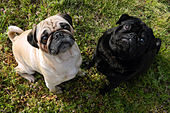Pug
The pug is a toy dog with a wrinkly, short-muzzled face and curled tail. The breed has a fine, glossy coat that comes in a variety of colors, although often black or fawn, and a compact square body with well-developed muscles. Known in ancient China as lo-sze, pugs as breeding animals may have contributed to the English Bulldog, the modern Pekingese and the King Charles Spaniel. Pugs were brought from China to Europe in the seventeenth century and were popularized in Western Europe by the House of Orange of the Netherlands, and the House of Stuart.[2] Pugs remain popular into the twenty-first century, with some famous celebrity owners. A pug was judged Best in Show at the World Dog Show in 2004.
History
16th and 17th centuries
The pug breed was imported into Europe from China in the 16th century by the Dutch East India Company. It is said to have become the official dog of the House of Orange in 1572 after a pug named Pompey saved the life of the Prince of Orange by alerting him to the approach of assassins.[1] A pug travelled with William III and Mary II when they left the Netherlands to accept the throne of England in 1688.[2] During this period, the pug may have been bred with the old type King Charles spaniel, giving the modern English Toy/King Charles Spaniel its pug characteristics.[6]
The breed eventually became popular in other European countries as well. Pugs were painted by Goya in Spain, and in Italy they rode up front on private carriages, dressed in jackets and pantaloons that matched those of the coachman. They were used by the military to track animals and people, and were also employed as guard dogs.[2]
18th century to present day
The English painter William Hogarth was the devoted owner of a series of pugs. His 1745 self-portrait, which is now in London's Tate Gallery, includes his pug, Trump.[7] The pug was also well known in Italy. In 1789, a Mrs. Piozzi wrote in her journal, "The little pug dog or Dutch mastiff has quitted London for Padua, I perceive. Every carriage I meet here has a pug in it."[8] The popularity of the pug continued to spread in France during the eighteenth century. Before her marriage to Napoleon Bonaparte, Joséphine had her pug Fortune carry concealed messages to her family while she was confined at Les Carmes prison, it having alone been given visiting rights.[9]
In nineteenth century England, the breed flourished under the patronage of Queen Victoria. Her many pugs, which she bred herself, included Olga, Pedro, Minka, Fatima and Venus.[2] Her involvement with dogs in general helped to establish the Kennel Club, which was formed in 1873.[2] Queen Victoria favoured apricot and fawn colors. In paintings and engravings of the 18th and 19th centuries, pugs usually appear with longer legs and noses than today, and with cropped ears. The modern pug's appearance probably changed after 1860 when a new wave of pugs were imported directly from China. These pugs had shorter legs and the modern-style pug nose. The British aristocrat Lady Brassey is credited with making black pugs fashionable after she brought some back from China in 1886. Ear cropping was made illegal in 1895.[10]
Pugs arrived in the United States during the nineteenth century and were soon making their way into the family home and the show ring.[2] The American Kennel Club recognized the breed in 1885. The Pug Dog Club of America was founded in 1931 and was recognized by the American Kennel Club that same year. In 1981, the pug Dhandys Favorite Woodchuck won the Westminster Kennel Club Dog Show in the United States, the only pug to have won there since the show began in 1877.[11] The World Champion, or Best in Show at the 2004 World Dog Show held in Rio de Janeiro, Brazil, was a pug named Double D Cinoblu's Masterpiece.[12]
 | ||||
| A fawn pug, the most common coloring. | ||||
| Other names | Chinese pug Dutch bulldog Dutch mastiff Mini mastiff Mops Carlin | |||
|---|---|---|---|---|
| Country of origin | China[1] | |||
| ||||
| ||||




No comments:
Post a Comment